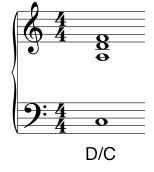Introduction
A Slash Chord is (generally) a Major triad over a bass note. Slash Chords are actually quite simple to understand, they are analysed like any other chord – by looking at the notes that comprise them.
Slash Chords are notated as Chord/Note. So a D/C reads ‘D slash C’ or ‘D over C’ and is a D Major Triad over a C Bass Note.

Slash Chords exist because:
- They are an easier way to read complex chord notation
- For example instead of writing CMaj7#9#11 (a complex looking chord), you can just write B/C
- They give a ready-made voicing for the chord
- They give you a ready-made bass-line (often a chromatic bass-line)
The triad can be played in any inversion but generally the 2nd inversion is considered the strongest.
Chord Ambiguity
Slash chords can be a bit ambiguous because they are often missing a few chord tones.
- Some are missing a 3rd and 7th – so can technically be either Major, minor or Dominant
- BUT you have to keep in mind each chord’s available tension
- For example, a minor chord cannot have a #11; therefore a Slash Chord that has a #11 must be either Major or Dominant
- D/C – has no 3rd or 7th so can be either CMaj13#11 or C13#11 (though usually the former) but cannot be Cm13#11
Slash Chords
The majority of Slash Chords use a Major triad on top; however, you can also use other chords, such as:
- Diminished, augmented or minor triads: Gm/C = C9
- 7th chords: Dm7/G = G9sus
- Including Maj7, min7, V7, Aug7, half dim, full dim chords
These Slash Chords are all analysed in the same way – by looking at the notes they are composed of.
Below is a list of all possible slash chords that use a Major triad with their effective chord name and related scales:
| Slash Chord | Notes | Effective Chord | Scale |
|---|---|---|---|
| C/C | C | C E G | CMaj | C Major C Lydian |
| D♭/C | C | D♭ F A♭ | D♭Maj7 Csus♭9♭13 (C7 sub) | C Locrian C Phrygian |
| D/C | C | D F# A | D7 CMaj13#11 C13#11 | C Lydian C Lydian C Lydian Dominant |
| E♭/C | C | E♭ G B♭ | Cm7 | C Dorian |
| E/C | C | E G# B | CMaj7#5 | C Lydian Augmented |
| F/C | C | F A C | FMaj | F Major |
| G♭/C | C | G♭ B♭ D♭ | C7♭5♭9 | C Altered C Half/Whole diminished |
| G/C | C | G B D | CMaj9 CmMaj9 | C Major C melodic minor |
| A♭/C | C | A♭ C E♭ | A♭ Major C7#9♭13 | A♭ Major C Altered |
| A/C | C | A C# E | C13♭9 | C Half/Whole diminished |
| B♭/C | C | B♭ D F | C9sus Cm11 | C Mixolydian C Dorian |
| B/C | C | B D# F# | CMaj7#9#11 (CMaj7 sub) Altered Co7 CmMaj7♭5 | C Whole/Half diminished |
We will come across the idea of simplifying chord notation by breaking the chord up into components in future lessons. For the moment, I will just list the different concepts that use this technique:
- Slash chord: D/C = 1 Bass note over a triad
- Upper Structure: USII = 2 Bass notes (tritone) over a triad
- Polychord:
 = (3 bass notes) Triad over a triad
= (3 bass notes) Triad over a triad
Have a Listen to
- On Green Dolphin Street ~ Bronisław Kaper
- Skylark ~ Hoagy Carmichael
- Black Orpheus ~ Luiz Bonfá
- Rhythm-a-Ning ~ Thelonious Monk
- Wave ~ Antonio Jobim
- Waltz for Debbie ~ Bill Evans